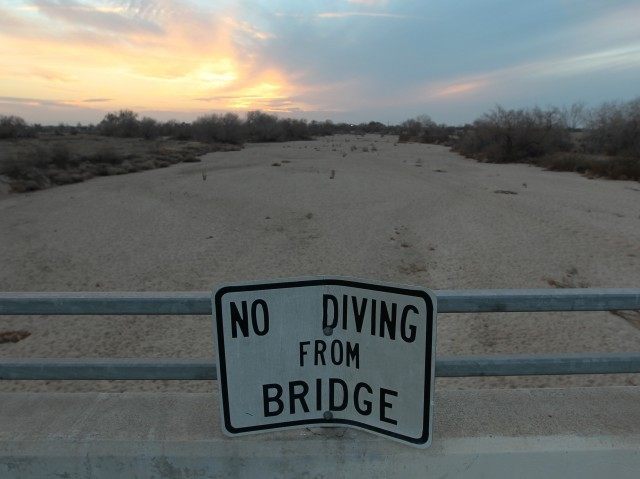Writing for the Los Angeles Times, reporter Thomas Curwen called California’s historic, four-year-long drought “serious, but hardly a disaster.”
In a piece titled, “California drought: No rain, but ‘the sky is not falling,'” Curwen makes two overarching points to support the claim.
First, he says, California has made its most important water innovations during times of extreme drought:
Water management in California has always had to contend with a fractured landscape, long divided by history and geography, and years of clear and cloudless skies have only heightened antagonisms and spurred innovation.
But nothing focuses political will better than a disaster.
Drought in the 1930s created the Central Valley Project. Drought in the 1950s led to the State Water Project. Drought in the 1970s spurred efforts at urban conservation and the state’s Drought Emergency Water Bank came out of drought in the 1980s.
Secondly, Curwen says California could learn about successful water management by studying the way the Santa Ana River is managed by the Santa Ana River Watershed Project Authority (SAWPA). The agency, created out of a legal settlement in 1969, rigorously tracks water usage across the entire Santa Ana River watershed, following where each drop of water is coming from and going, and coordinating amongst its member water districts to fund projects and debate policy.
Curwen writes:
The legacy of this drought, Californians deeply involved in water issues say, is that the state will adjust, as it always has following a dry period, and this time the adjustment will mean managing water across the state much like the Santa Ana River is managed.
On this second point, Curwen is correct; when compared with the roughly 4,000 individual water agencies spread out across the state, squabbling over water rights and consumption rates, California would likely benefit from a reduction in bureaucracy.
As Joe Grindstaff, general manager of SAWPA member agency Inland Empire Utilities, put it to the Times: “One problem is that the agencies compete with one another, rather than work together. That takes a lot of resources. My belief is that if you look at California in 50 years, instead of thousands of agencies, we might have 50 to 100.”
But on his first point, that California’s best innovations come under pressure, Curwen underestimates the severity of the state’s bureaucratic gridlock and the increasing influence of its politically powerful environmental groups.
According to a recent Field Poll, a strong majority of California voters (68%) characterize the drought as “extremely serious.” The same poll found that just 10% of Californians believe the current water storage and supply facilities are adequate to meet the water needs of the state.
While Caltech engineering professor and water researcher John Hall can tell the Times that “it’s hard to see how we can engineer our way out of [drought],” the reality is that there is little California can do, conservation executive orders and groundwater laws notwithstanding, to shore up protection against the drought. The state cannot make rain; it can only maximize its storage and supply facilities to protect against future drought.
The state has been hampered in that process for nearly three decades. The latest blow came in late April, when the predominantly Democrat Assembly Natural Resources and Transportation committee shot down a trio of bills designed to allow construction of important, large-scale water storage projects to begin or continue while time-intensive California Environmental Quality Act (CEQA) impact reports are completed. Environmental advocates have used CEQA lawsuits to delay water construction projects for decades, including for projects with minimal ecological impact like the long-stalled Sites Reservoir dam project in Colusa County.
The state can, and has, invested in desalination technology to help battle the drought. California water watchers are waiting patiently to see how Carlsbad’s $1 billion desalination facility, set to open later this year, can help contribute to water agencies’ available supply.
But environmental interests and fiscal hawks are not convinced that the facilities offer a long-term solution. The plants are expensive, and environmental groups claim that intake and outflow pipes harm the ecology of the Pacific Ocean.
California is spending a lot of money (that it doesn’t have) to fight the drought. A $7.5 billion water bond approved by state voters in November promised to earmark about $2.8 billion for the construction of above-ground water storage facilities and improvements in groundwater storage. But the bond’s crafty language includes the stipulation that “a project shall not be funded…unless it provides measurable improvements to the Delta ecosystem or to the tributaries to the Delta.” Enter the unelected, Gov. Jerry Brown-appointed California Water Commission, who are almost sure to kill any much-needed storage or supply proposal because of the potential harm it could cause to a three-inch baitfish.
Curwen’s optimism is admirable, and as drought headlines continue to slide further into apocalyptic speculation, it is important to know exactly where the state stands in its fight against the drought. There are certainly reasons to be optimistic; at the very least, private companies and young entrepreneurs have taken up the state’s water shortage problem with enthusiasm, if not readily available solutions.
But unless the state’s politically powerful environmental groups are willing to make their own sacrifices, as agricultural interests and urban water users already have, then California can continue to expect bureaucratic gridlock, and consequently, little innovative success, in its fight against the drought.

COMMENTS
Please let us know if you're having issues with commenting.